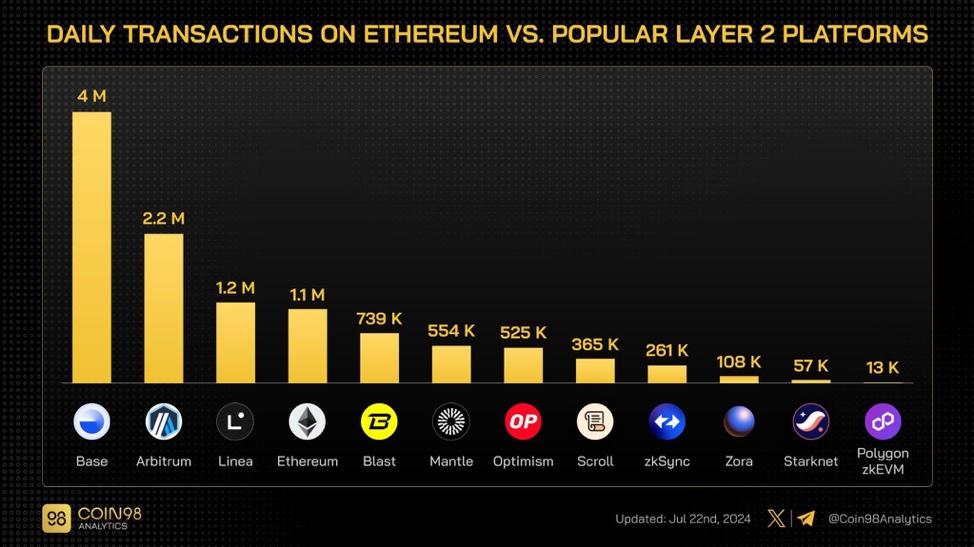What is Base Network? A Guide to the Layer 2 Solution and Its Promising Projects
2025/02/12 17:46:15

Key Points:
Base Network's rapid growth is largely driven by its strong support from Coinbase and seamless integration with the OP Stack which positions it as a leading Layer-2 solution in the blockchain space.
Base has successfully leveraged meme culture and SocialFi to attract significant user interest and capital inflow, outpacing competitors in transaction volumes and user engagement.
Leading projects like Aerodrome Finance, Brett, and SeamlessFi are critical to Base’s ecosystem as driving liquidity, user adoption, and financial success on the network.
Base’s rapid rise was driven by its strong backing from Coinbase and its integration with the OP Stack. These key factors, along with its strong presence in the "Memecoins" and "SocialFi" sectors, have pushed Base to the forefront of the Layer 2 space. Base leading projects like Aerodrome Finance (AERO), Brett (BRETT), and SeamlessFi (SEAM) have also played a big role in its growth. The Layer 2 competition, once dominated by Arbitrum and Optimism, is heating up. As the Layer 2 landscape evolves, what’s next for Base?
The Base ecosystem which was developed by Coinbase is a new cutting-edge Layer-2 solution designed to address key challenges faced by the Ethereum blockchain, such as scalability, high transaction costs, and user experience for decentralized applications (DApps). Since its launch in August 2023, Base has rapidly become one of the fastest-growing Layer-2 networks. Notably, Base does not plan to introduce a new token, instead using ETH as its gas token.
Despite its origin within a centralized exchange, Base is committed to progressive decentralization in order to ensure it aligns with the principles of an open crypto economy. Leveraging the OP Stack, Base offers a secure, stable, and scalable environment for on-chain applications. The ecosystem’s strong integration with Coinbase’s extensive user base, coupled with its independent operation, positions Base as a key player in the future of the DeFi sector.
According to data by August 14, Base's Total Value Locked (TVL) had soared to nearly $6.3 billion making Base the second-largest Layer 2 network. Given that Base is built as a superchain on the OP Stack, its rise seems almost inevitable. But what’s really behind Base’s rapid climb? How has its connection with Web3 giants like Coinbase played into this, and which projects in the Base ecosystem should we be keeping an eye on? This guide will delve into the Base ecosystem’s growth, leading projects and its advantages.
What is Base Network?
Base is a Layer-2 blockchain solution developed by Coinbase, designed to address the growing demand for faster, more secure, and cost-effective transactions within the Ethereum ecosystem. As the use of blockchain technology and cryptocurrencies expands, so does the need for scalable solutions that can handle increased transaction volumes without compromising on speed or security. Base meets this need by building on Ethereum’s Layer-2 infrastructure, which allows it to process transactions more efficiently while reducing costs. Unlike many other blockchain platforms, Base is specifically engineered to support DApps, making it a vital component of the broader push towards a decentralized web.
The technology behind Base leverages Ethereum’s Layer-2 blockchain, which handles transaction-heavy processes off the main Ethereum network, known as Layer 1. By utilizing the OP Stack, an open-source development platform, Base offers developers a familiar and seamless environment for creating and deploying blockchain applications. This approach not only ensures compatibility with existing Ethereum tools and frameworks but also enhances the overall efficiency of the network by reducing the load on Ethereum’s mainnet. Launched in August 2023, Base has quickly become one of the fastest-growing Layer-2 networks, accumulating nearly $6 billion in total value locked. While Base benefits from its close ties to Coinbase, it operates independently with a strong commitment to progressive decentralization. The network uses ETH as its gas token, maintaining its integration with the broader Ethereum ecosystem while offering a secure, scalable, and accessible platform for both developers and users.

Base Network Total Value Locked, Source: growthepie
How Does Base L2 Network Work?
Base Network operates as an Ethereum L2 blockchain designed to enhance the performance, scalability, and cost-efficiency of DApps on the Ethereum network. At its core, Base utilizes a technology called "rollups" to process transactions off-chain before batching and submitting them to the Ethereum mainnet (Layer 1) for final validation. This approach significantly reduces the computational load on Ethereum's mainnet, resulting in faster transaction times and lower fees, while still benefiting from the security of the underlying Ethereum network.
Rollups work by aggregating multiple transactions into a single batch and then submitting this batch as one transaction to the Ethereum mainnet. This method drastically reduces the number of transactions that need to be processed directly on Ethereum, which is often slow and costly during periods of high network congestion. By handling most of the transaction-heavy work off-chain, Base ensures that users experience faster, cheaper transactions without sacrificing security.
Base is built on the OP Stack, an open-source development platform that provides a flexible and developer-friendly environment. This stack allows developers who are already familiar with Ethereum to easily build and deploy their DApps on Base without needing to learn new tools or rewrite existing code. Additionally, Base maintains full compatibility with Ethereum’s existing ecosystem, meaning that DApps, smart contracts, and other blockchain applications developed on Ethereum can seamlessly integrate with Base.
Moreover, Base is designed to be interoperable with other blockchain networks and platforms, further expanding its utility and appeal. The network’s close integration with Coinbase provides an added layer of accessibility, offering users seamless onramps and offramps for fiat currency, making it easier for both individuals and businesses to engage with the blockchain ecosystem. Base is particularly suited for DeFi platforms, non-fungible token (NFT) marketplaces, gaming and virtual worlds, social media platforms, and supply chain and logistics applications. Its compatibility with Ethereum-based tools and frameworks makes it an attractive platform for developers and users alike.

Base L2 Application Across Sectors, Source: growthepie
Advantage of Base Network
Base Network, as a Layer-2 solution developed by Coinbase, offers several key advantages that make it a compelling choice for developers, businesses, and users within the blockchain ecosystem. Here are the primary benefits:
Faster Transactions: One of the standout features of Base Network is its ability to process transactions much more quickly than the Ethereum mainnet. By utilizing rollups, Base aggregates multiple transactions off-chain and submits them as a single batch to the Ethereum network. This reduces the time it takes for transactions to be confirmed, making it a more efficient and user-friendly option, especially during periods of high network activity.
Lower Transaction Fees: Transaction fees on the Ethereum mainnet can be prohibitively high, particularly during times of network congestion. Base addresses this issue by processing transactions off-chain, which significantly reduces the gas fees required for each transaction. This cost-effectiveness is a major draw for both developers and users, making frequent transactions and complex DApps more affordable.

Top 2 transaction costs and different L2 chains, Source: growthepie
Scalability: Base is designed to handle a high volume of transactions efficiently, offering a scalable solution that can grow alongside the expanding blockchain ecosystem. As more users and applications join the network, Base can accommodate increased activity without compromising on performance or speed.
Interoperability: Base maintains full compatibility with Ethereum-based tools, frameworks, and applications, allowing developers to seamlessly transition their existing projects to the Base Network without the need for extensive modifications. This interoperability extends to other blockchain networks as well, providing a flexible platform for cross-chain interactions and integrations.
Developer-Friendly Environment: Built on the OP Stack, Base offers a development environment that is both familiar and accessible to those already working within the Ethereum ecosystem. Developers can use their existing Ethereum knowledge and tools to build on Base, which reduces the learning curve and accelerates the development process. Additionally, Base’s open-source nature encourages innovation and collaboration within the community.
Security: While operating as a Layer-2 solution, Base still leverages the robust security of the Ethereum mainnet. By submitting bundled transactions to Ethereum for final validation, Base ensures that its operations are underpinned by the same high security standards that protect the Ethereum network. This makes it a reliable platform for handling sensitive transactions and deploying critical applications.
Cost-Effective Development: With lower transaction fees and a familiar development environment, Base significantly reduces the cost barriers for developers looking to build and scale their DApps. This makes it an attractive platform for both startups and established enterprises aiming to deploy blockchain solutions without incurring the high costs associated with Layer-1 Ethereum transactions.
Why Has Base Network Become So Popular?
Base has quickly become a prominent player in the cryptocurrency space. Base leverages Optimism's open-source modular toolkit in order to allow developers to create customizable Layer 2 solutions that tap into the security and resources of the Ethereum network. The network's rapid rise to success can be attributed to several factors, including its deep connection to consumer applications, a strong governance and revenue-sharing framework with Optimism, and a unique approach to leveraging the power of social applications and meme culture.
The roots of Base's popularity can be traced back to its origins. Jesse Pollak, a seasoned veteran at Coinbase, conceived the idea while leading the company's consumer products in 2021. With the support of Coinbase CEO Brian Armstrong, Pollak set out to bring Coinbase onto the blockchain, leading to the creation of Base. This background imbued Base with a natural affinity for consumer applications, a trait that has played a crucial role in its widespread adoption.
Base's success is also intertwined with its strategic focus on meme culture and SocialFi. By fostering a series of wealth-creating "meme" phenomena, Base has managed to attract substantial user interest and capital inflow. Moreover, its integration with popular social platforms like friend.tech and Farcaster has solidified its reputation as a leading network in the emerging Web3 social space. This dual approach has not only driven high transaction volumes and user engagement but also positioned Base as a top-tier Layer 2 network, outpacing competitors like Optimism or Arbitrum in various key metrics.
Coinbase's role as the sole sequencer on the Base network has also contributed to its financial success. The network's impressive performance, with daily transactions reaching record highs, underscores its growing influence and competitiveness. Even without the expectation of issuing a native token, Base has established itself as a formidable presence in the Layer 2 landscape.

Base Network As Top 1 Daily Transactions on Ethereum, Source: COIN98
Top and Promising Crypto Projects to Watch on the Base Network
The growth and sustainability of a Layer 2 network depend not only on its technological advancements and popularity but also on the strength of its ecosystem. So, how far has the Base network's ecosystem evolved, and which standout projects across various sectors are worth keeping an eye on? Beyond the well-known players like friend.tech, Uniswap, and AAVE, a new wave of DeFi projects is shaping the landscape. Here are some of the trending Base projects that you should consider adding to your portfolio and keeping an eye on:
Aerodrome Finance (AERO): Empower Decentralized Liquidity on the Base Network
Aerodrome Finance is the DeFi protocol designed to enhance liquidity and streamline automated market making (AMM) on the Base network. Launched on August 28, 2023, Aerodrome serves as the central liquidity hub for Base by utilizing advanced technology inherited from Velodrome V2 which is a leading DEX on the Optimism network. Aerodrome employs a dual-token system where AERO (an ERC-20 token) is used to reward liquidity providers, while veAERO (an ERC-721 token) represents governance power within the protocol. By locking AERO tokens, users receive veAERO NFTs, enabling them to participate in governance decisions, such as determining AERO emission allocations. This system ensures that liquidity is directed where it is most needed.

AERO as Top Protocol Rankings on Base Network, Source: Defilama
The platform's unique approach combines the best features of successful decentralized exchanges like Curve, Convex, and Uniswap V2. This makes it a one-stop shop for liquidity provision and trading on the Base network. Aerodrome Finance not only incentivizes liquidity providers with AERO tokens but also empowers them to influence the platform's direction through a democratic governance model. This system aligns the interests of the community with the protocol's growth, enhancing the overall resilience and sustainability of the Base ecosystem. By fostering USDC adoption, supporting liquid staked tokens, and forming strategic partnerships, Aerodrome plays a crucial role in driving the growth and stability of the Base network.

Brett (BRETT): Top Base Network Memecoin
BRETT is a new memecoin in the cryptocurrency world, launched on the Base blockchain and inspired by the character Brett from the Boy's Club comic series. Unlike many memecoins, BRETT stands out with its unique features, such as a renounced contract and the absence of a minting function, ensuring that the token's future is entirely in the hands of the community. This decentralized approach has resonated with crypto enthusiasts, contributing to its rapid rise in popularity. The token boasts a market cap of over $835 million, making it the top 10 largest in the Base ecosystem. Despite its playful origin, BRETT has garnered significant attention, thanks to its strategic partnerships and a strong, growing community.

SeamlessFi (SEAM): Leading the Future of DeFi with Innovative Lending Protocols
SeamlessFi as a DeFi protocol on the Base Network specializes in lending and borrowing services. As the first of its kind on Base, SeamlessFi has quickly become one of the top three native applications by TVL which was surpassing $511 million. The protocol's success is driven by a team with experience in leading projects like AAVE and Uniswap. SeamlessFi offers innovative lending solutions, including both over-collateralized and under-collateralized loans, and introduces Integrated Liquidity Markets (ILMs) to enhance borrowing strategies. The SEAM token serves as the governance token with a significant portion dedicated to community rewards and activities.

Conclusion
The Base Network is set to play a crucial role in the expansion of the Ethereum ecosystem and the broader crypto economy by providing a scalable and user-friendly platform for DApp development and deployment. With its strong commitment to open-source principles, interoperability, and a seamless user experience, supported by its robust infrastructure and strategic partnerships, Base Network stands out as a key contributor to the next wave of blockchain innovation.
Just within a year, Base has achieved remarkable success, rising to the top of the L2 networks and attracting $6 billion in TVL, all without issuing native tokens. This rapid ascent highlights Base's potential as a leader in the L2 space, particularly in relation to its unique advantages in social and other Web3 consumer applications. While the past provides valuable lessons, Base's trajectory offers a rare and instructive example for those striving to make their mark in the Web3 space. As the Web3 landscape evolves, Base may serve as a blueprint for achieving explosive growth and widespread adoption in the next era of digital innovation. As Base continues to evolve and expand its ecosystem, it is poised to play a crucial role in the future of DeFi and beyond.
FAQ
Q: What Is Base Network and How Does It Work?
A: Base Network is a Layer 2 blockchain solution developed by Coinbase to enhance the performance, scalability, and cost-efficiency of DApps on the Ethereum network. It uses rollups to process transactions off-chain, which are then validated on the Ethereum mainnet which results in faster transaction times and lower fees.
Q: What Are the Key Projects on the Base Network?
A: The Base Network hosts several promising projects, including Aerodrome Finance, a DeFi protocol enhancing liquidity; Brett, a memecoin with a strong community-driven approach; and SeamlessFi, a lending protocol offering innovative solutions for decentralized finance. These projects are pivotal in driving the network's growth and adoption. The Other Base Network includes Base God (TYBG), a community-driven, meme-inspired project featuring a metaverse space for social interactions, and Bloo Foster Coin (BLOO), a memecoin with a heartwarming narrative.
Q: Why Is Base Network Becoming Popular in the Blockchain Space?
A: Base Network's popularity is driven by its strong backing from Coinbase, integration with the OP Stack, and focus on SocialFi and memecoins. Its ability to offer a scalable, secure, and cost-effective environment for decentralized applications has made it a leading player in the L2 blockchain landscape.
Disclaimer: The information provided in this article is intended only for educational and reference purposes and should not be considered investment advice. For more information, please refer to here Conduct your own research and seek advice from a professional financial advisor before making any investment decisions. FameEX is not liable for any direct or indirect losses incurred from the use of or reliance on the information in this article.
